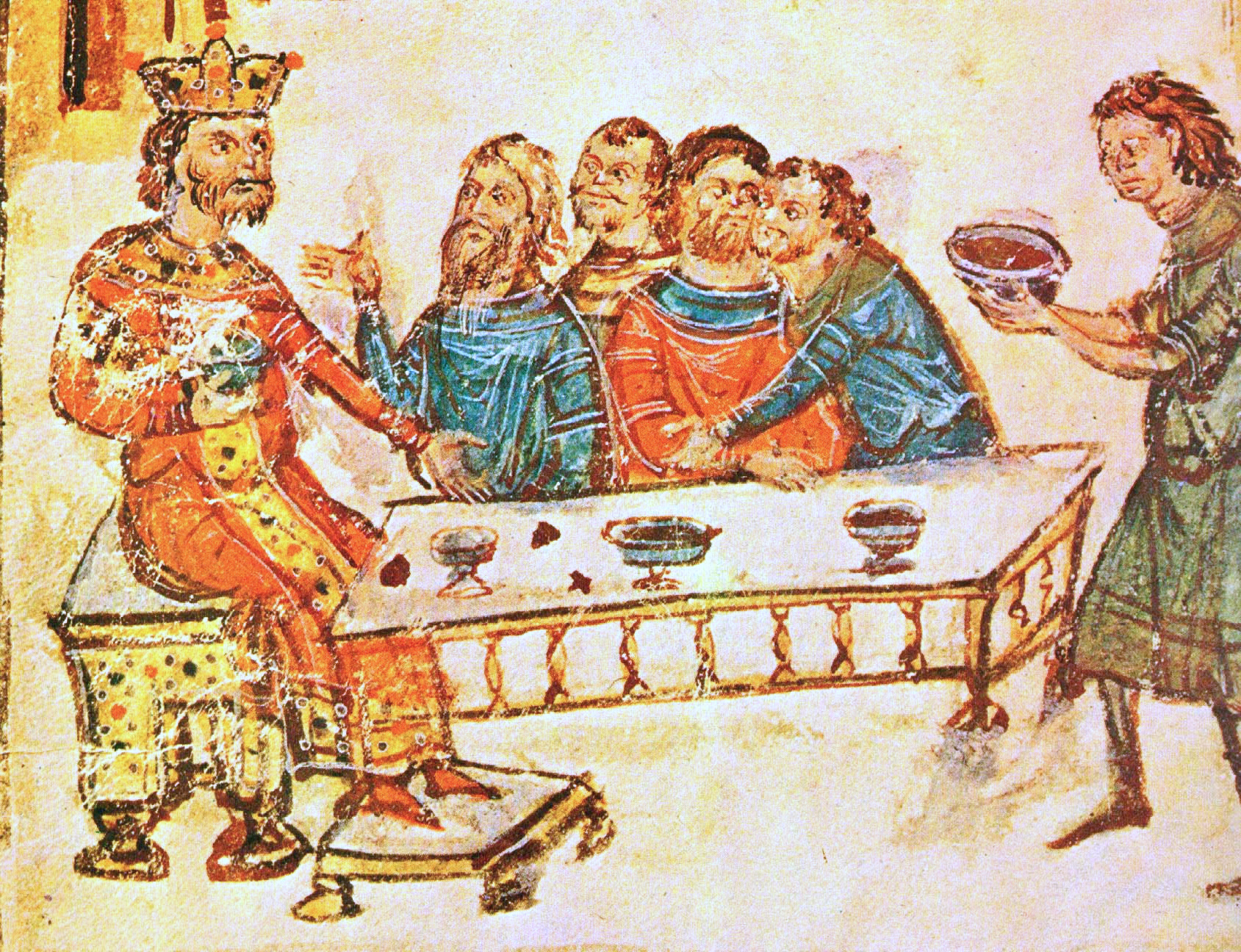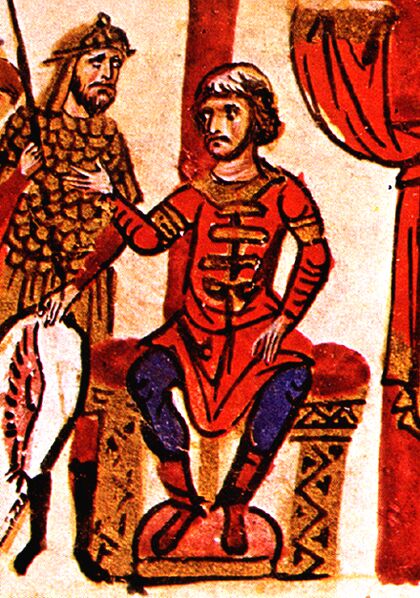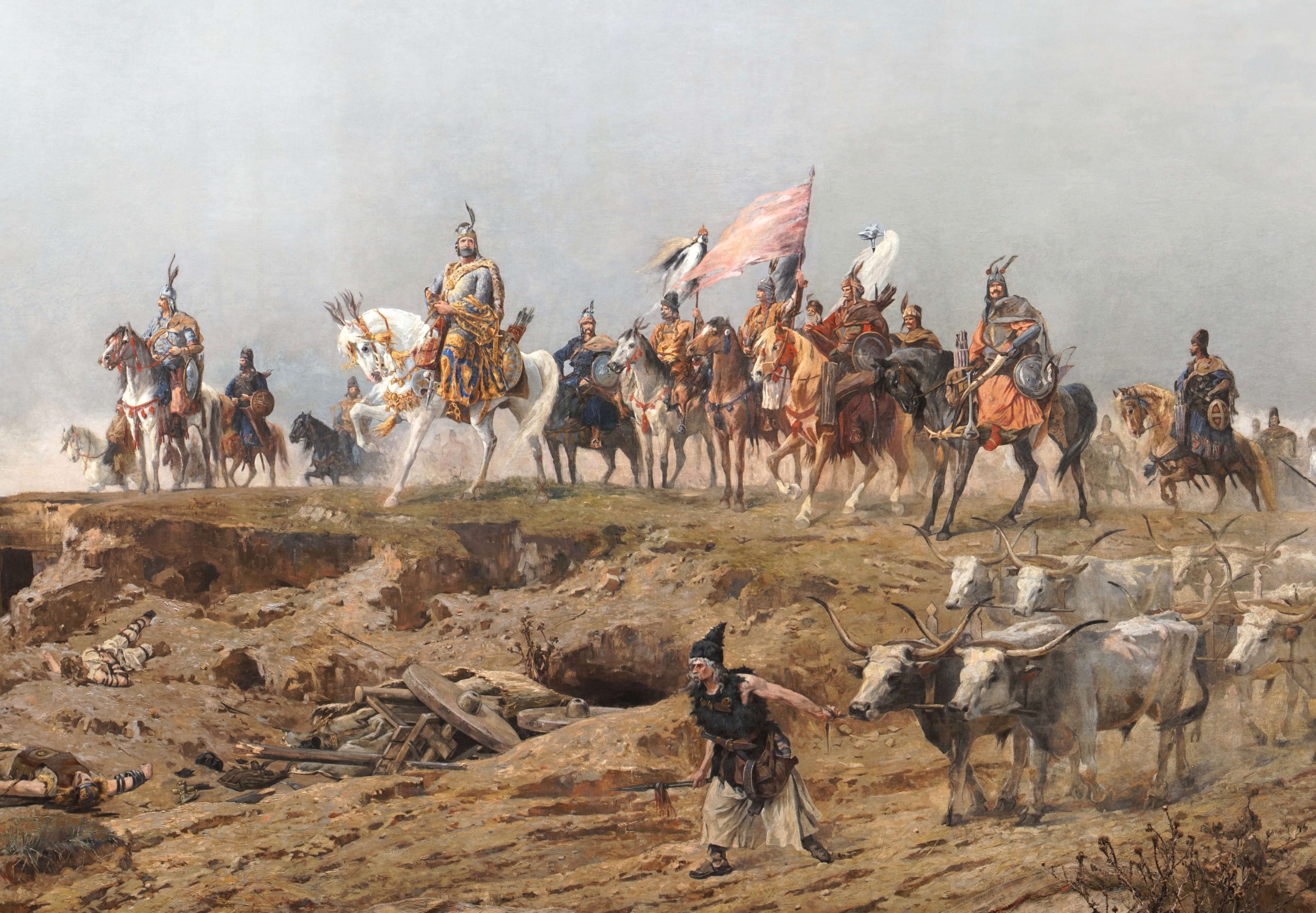|
Medieval Bulgarian Army
The medieval Bulgarian army was the primary military body of the First and the Second Bulgarian Empires, and some Puppet states of the former, like the Despotate of Dobruja. During the first decades after the foundation of the country, the army consisted of a Bulgar cavalry and a Slavic infantry. The core of the Bulgarian army was the heavy cavalry, which consisted of ca. 12,000 heavily armed riders. At its height in the 9th and 10th centuries, it was one of the most formidable military forces in Europe and was feared by its enemies. There are several documented cases of Byzantine commanders abandoning an invasion because of a reluctance to confront the Bulgarian army on its home territory. The army was intrinsically linked to the very existence of the Bulgarian state. Its success under Tsar Simeon I the Great marked the creation of a wide-ranging empire, and its defeat in a prolonged war of attrition in the early 11th century meant the end of Bulgarian independence. When the Bu ... [...More Info...] [...Related Items...] OR: [Wikipedia] [Google] [Baidu] |
Bulgarian Empire
In the medieval history of Europe, Bulgaria's status as the Bulgarian Empire ( bg, Българско царство, ''Balgarsko tsarstvo'' ) occurred in two distinct periods: between the seventh and the eleventh centuries and again between the twelfth and the fourteenth centuries. The two "Bulgarian Empires" are treated not as separate entities but rather as one state that was restored after a period of Byzantine rule over its territory. First Bulgarian Empire Moesia was repeatedly invaded by both Slavs and Bulgars during the 5th, 6th and 7th centuries. In 499, the Bulgars crossed Danube and reached Thrace where on the banks of the river Tzurta (considered a tributary of Maritsa) defeated 15,000 men strong Roman army led by magister militum Aristus. In the 670s under the rule of Asparukh the Bulgars settled further south on territories of the Eastern Roman Empire in Scythia Minor near the Danube Delta in a region called Ongal and allied with the local Slavs. Their ho ... [...More Info...] [...Related Items...] OR: [Wikipedia] [Google] [Baidu] |
Khazars
The Khazars ; he, כּוּזָרִים, Kūzārīm; la, Gazari, or ; zh, 突厥曷薩 ; 突厥可薩 ''Tūjué Kěsà'', () were a semi-nomadic Turkic people that in the late 6th-century CE established a major commercial empire covering the southeastern section of modern European Russia, southern Ukraine, Crimea, and Kazakhstan. They created what for its duration was the most powerful polity to emerge from the break-up of the Western Turkic Khaganate. Astride a major artery of commerce between Eastern Europe and Western Asia, Southwestern Asia, Khazaria became one of the foremost trading empires of the Early Middle Ages, early medieval world, commanding the western March (territory), marches of the Silk Road and playing a key commercial role as a crossroad between China, the Middle East and Kievan Rus'. For some three centuries (c. 650–965) the Khazars dominated the vast area extending from the Volga-Don steppes to the eastern Crimea and the northern Caucasus. Khazari ... [...More Info...] [...Related Items...] OR: [Wikipedia] [Google] [Baidu] |
Latin Empire
The Latin Empire, also referred to as the Latin Empire of Constantinople, was a feudal Crusader state founded by the leaders of the Fourth Crusade on lands captured from the Byzantine Empire. The Latin Empire was intended to replace the Byzantine Empire as the Western-recognized Roman Empire in the east, with a Catholic emperor enthroned in place of the Eastern Orthodox Roman emperors. The Fourth Crusade had originally been called to retake the Muslim-controlled city of Jerusalem but a sequence of economic and political events culminated in the Crusader army sacking the city of Constantinople, the capital of the Byzantine Empire. Originally, the plan had been to restore the deposed Byzantine Emperor Isaac II Angelos, who had been usurped by Alexios III Angelos, to the throne. The crusaders had been promised financial and military aid by Isaac's son Alexios IV, with which they had planned to continue to Jerusalem. When the crusaders reached Constantinople the situation quickly ... [...More Info...] [...Related Items...] OR: [Wikipedia] [Google] [Baidu] |
Kievan Rus'
Kievan Rusʹ, also known as Kyivan Rusʹ ( orv, , Rusĭ, or , , ; Old Norse: ''Garðaríki''), was a state in Eastern and Northern Europe from the late 9th to the mid-13th century.John Channon & Robert Hudson, ''Penguin Historical Atlas of Russia'' (Penguin, 1995), p.14–16.Kievan Rus Encyclopædia Britannica Online. Encompassing a variety of polities and peoples, including East Slavic, Norse, and Finnic, it was ruled by the , fou ... [...More Info...] [...Related Items...] OR: [Wikipedia] [Google] [Baidu] |
Kingdom Of Croatia (925–1102)
The Kingdom of Croatia ( hr, Kraljevina Hrvatska; la, Regnum Croatiae), or Croatian Kingdom ( hr, Hrvatsko Kraljevstvo), was a medieval kingdom in Southern Europe comprising most of what is today Croatia (without western Istria and some Dalmatian coastal cities), as well as most of the modern-day Bosnia and Herzegovina. The Croatian Kingdom was ruled for part of its existence by ethnic dynasties, and the Kingdom existed as a sovereign state for nearly two centuries. Its existence was characterized by various conflicts and periods of peace or alliance with the Bulgarians, Byzantines, Hungarians, and competition with Venice for control over the eastern Adriatic coast. The goal of promoting the Croatian language in the religious service was initially introduced by the 10th century bishop Gregory of Nin, which resulted in a conflict with the Pope, later to be put down by him. In the second half of the 11th century Croatia managed to secure most coastal cities of Dalmatia with the c ... [...More Info...] [...Related Items...] OR: [Wikipedia] [Google] [Baidu] |
Duchy Of Croatia
The Duchy of Croatia (; also Duchy of the Croats, hr , Kneževina Hrvata; ) was a medieval state that was established by White Croats who migrated into the area of the former Roman province of Dalmatia 7th century CE. Throughout its existence the Duchy had several seats – namely, Klis, Solin, Knin, Bijaći and Nin. It comprised the '' littoral –'' the coastal part of today's Croatia ''–'' except Istria, and included a large part of the mountainous hinterland as well. The Duchy was in the center of competition between the Carolingian Empire and the Byzantine Empire for rule over the area. Croatian rivalry with Venice emerged in the first decades of the 9th century and would continue through the following centuries. Croatia also waged battles with the Bulgarian Empire (founded ; Bulgar-Croatian relations improved greatly afterwards) and with the Arabs; it also sought to extend its control over important coastal cities under the rule of Byzantium. Croatia experienced ... [...More Info...] [...Related Items...] OR: [Wikipedia] [Google] [Baidu] |
History Of Medieval Serbia
Serbia in the Middle Ages refers to the medieval period in the history of Serbia. The period begins in the 6th century with the Slavic migrations to Southeastern Europe, and lasts until the Ottoman Serbia, Ottoman conquest of Serbian lands in the second half of the 15th century. The period is also extended to 1537, when Pavle Bakić, the last titular Despot of Serbia in Hungarian exile, fell in the Battle of Gorjani. Introduction Background During the 6th century, at the beginning of the early medieval period, territory of later Serbia was controlled mainly by the Byzantine Empire (southern and central regions), and also by Byzantine neighboring rivals, the Gepid Kingdom and the Ostrogothic Kingdom (northern regions). During the reign of Byzantine emperor Justinian I (527–565), defensive structures in the region were reinforced. In 535, the newly founded city of Justiniana Prima became center of the Archbishopric of Justiniana Prima, with metropolitan jurisdiction over ... [...More Info...] [...Related Items...] OR: [Wikipedia] [Google] [Baidu] |
Kingdom Of Hungary
The Kingdom of Hungary was a monarchy in Central Europe that existed for nearly a millennium, from the Middle Ages into the 20th century. The Principality of Hungary emerged as a Christian kingdom upon the coronation of the first king Stephen I at Esztergom around the year 1000;Kristó Gyula – Barta János – Gergely Jenő: Magyarország története előidőktől 2000-ig (History of Hungary from the prehistory to 2000), Pannonica Kiadó, Budapest, 2002, , p. 687, pp. 37, pp. 113 ("Magyarország a 12. század második felére jelentős európai tényezővé, középhatalommá vált."/"By the 12th century Hungary became an important European factor, became a middle power.", "A Nyugat részévé vált Magyarország.../Hungary became part of the West"), pp. 616–644 his family (the Árpád dynasty) led the monarchy for 300 years. By the 12th century, the kingdom became a European middle power within the Western world. Due to the Ottoman occupation of the central and south ... [...More Info...] [...Related Items...] OR: [Wikipedia] [Google] [Baidu] |
Principality Of Hungary
The (Grand) Principality of HungaryS. Wise BauerThe history of the medieval world: from the conversion of Constantine to the First Crusade W. W. Norton & Company, 2010, p. 586George H. HodosThe East-Central European region: an historical outline Greenwood Publishing Group, 1999, p. 19 or Duchy of Hungary ( hu, Magyar Nagyfejedelemség: "Hungarian Grand Principality" Byzantine gr, Τουρκία) was the earliest documented Hungarian state in the |
Magyar Tribes
The Magyar tribes ( , hu, magyar törzsek) or Hungarian clans were the fundamental political units within whose framework the Hungarians (Magyars) lived, before the Hungarian conquest of the Carpathian Basin and the subsequent established the Principality of Hungary.George H. HodosThe East-Central European region: an historical outline Greenwood Publishing Group, 1999, p. 19 Etymology The ethnonym of the Hungarian tribal alliance is uncertain. According to one view, following Anonymus's description, the federation was called "Hetumoger" (modern Hungarian: '''hét magyar - Seven Magyars) (''"VII principales persone qui Hetumoger dicuntur"'', "seven princely persons who are called Seven Magyars"), though the word "Magyar" possibly comes from the name of the most prominent Hungarian tribe, called ''Megyer''. The tribal name "Megyer" became "Magyar" referring to the Hungarian people as a whole. Written sources called Magyars "Hungarians" before the conquest of the Carpathian Basin ... [...More Info...] [...Related Items...] OR: [Wikipedia] [Google] [Baidu] |
Kingdom Of The East Franks
The Kingdom of Germany or German Kingdom ( la, regnum Teutonicorum "kingdom of the Germans", "German kingdom", "kingdom of Germany") was the mostly Germanic-speaking East Frankish kingdom, which was formed by the Treaty of Verdun in 843, especially after the kingship passed from Frankish kings to the Saxon Ottonian dynasty in 919. The king was elected, initially by the rulers of the stem duchies, who generally chose one of their own. After 962, when Otto I was crowned emperor, East Francia formed the bulk of the Holy Roman Empire, which also included the Kingdom of Italy and, after 1032, the Kingdom of Burgundy. Like medieval England and medieval France, medieval Germany consolidated from a conglomerate of smaller tribes, nations or polities by the High Middle Ages. The term ''rex teutonicorum'' ("king of the Germans") first came into use in Italy around the year 1000. It was popularized by the chancery of Pope Gregory VII during the Investiture Controversy (late 11th century), ... [...More Info...] [...Related Items...] OR: [Wikipedia] [Google] [Baidu] |
Carolingian Empire
The Carolingian Empire (800–888) was a large Frankish-dominated empire in western and central Europe during the Early Middle Ages. It was ruled by the Carolingian dynasty, which had ruled as kings of the Franks since 751 and as kings of the Lombards in Italy from 774. In 800, the Frankish king Charlemagne was crowned emperor in Rome by Pope Leo III in an effort to transfer the Roman Empire from Byzantine Empire to Europe. The Carolingian Empire is considered the first phase in the history of the Holy Roman Empire. After a civil war (840–843) following the death of Emperor Louis the Pious, the empire was divided into autonomous kingdoms, with one king still recognised as emperor, but with little authority outside his own kingdom. The unity of the empire and the hereditary right of the Carolingians continued to be acknowledged. In 884, Charles the Fat reunited all the Carolingian kingdoms for the last time, but he died in 888 and the empire immediately split up. With the only r ... [...More Info...] [...Related Items...] OR: [Wikipedia] [Google] [Baidu] |



.png)



